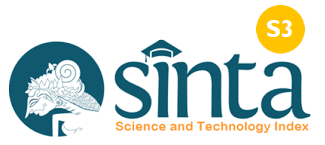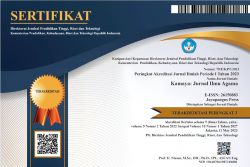Kualitas Buku Teks “Ajar Basa Jawa” Kelas IV SD Berdasarkan Parameter BSNP Dan Uji Fry
DOI:
https://doi.org/10.37329/kamaya.v8i1.3904Keywords:
Textbook Readability, BSNP, Fry TestAbstract
The assessment of the quality of textbooks is important to be studied in order to measure their suitability to the needs of students and alignment with the curriculum. The Textbook "Ajar Basa Jawa (ABJ)" is a Javanese language subject book used for elementary school students in the Special Region of Yogyakarta. This study uses a qualitative approach based on BNSP parameters and quantitatively based on the readability of the Fry test. The research method in this study is descriptive research. The research instruments consist of (1) the readability quality of the Fry Graph readability parameter and (2) the readability parameter instrument from BSNP. The BSNP parameter book quality instrument consists of the eligibility of (a) content, (b) language, (c) presentation, and (d) graphics. The validity of the data is obtained by the validity technique of diligent and accurate observation, repeated studies, and peer checking. Qualitative analysis with BSNP parameters and quantitative based on Fry Graph. The results (1) based on the Fry Graph analysis, the ABJ book for grade 4 elementary school does not meet the readability as a good grade 4 book. Based on BSNP parameters, the ABJ book is in the less category, and based on the fry test mapping it is more suitable for class 7. This is caused by (a) words with 3-4 syllables, (b) difficult words, (c) various typos/imprecisions by the author, (d) ambiguous words, and (e) sentences that are too long. The use of the Ajar Basa Jawa textbook needs to be aligned with the development of students and the applicable Javanese curriculum in elementary schools.
References
Aisyah, S., Haryanti, D., Sabardila, A., & Maudi, A. G. (2019). Class Shift of Verbs and Readability in Harry Potter and the Half Blood Prince. International Conference on Language, Literature, and Arts Education (ICLLAE 2019), 232–236.
Basuki, W. N., dkk. (2015). Analisis Isi Buku Ajar Bahasa Indonesia Wahana Pengetahuan untuk SMP/MTs Kelas VIII. BASASTRA: Jurnal Penelitian Bahasa, Sastra Indonesia dan Pengajarannya, 3(2). ISSN 2302-6405.
Brozo, W. G. (2005). Connecting with Students Who Are Disinterested and Inexperienced. Thinking Classroom, 6(3), 42.
Chotimah, C., Untari, M. F. A., & Budiman, M. A. (2019). Analisis Penerapan Unggah-Ungguh Bahasa Jawa dalam Nilai Sopan Santun. International Journal of Elementary Education, 3(2), 202–209.
Dewantara, K. H. (2013). Ki Hajar Dewantara: Pemikiran, Konsepsi, Keteladanan, dan Sikap Merdeka (Pendidikan). Yogyakarta: UST Press.
Dmitry, A. T., Sergeev, A. P., & Filimonov, V. V. (2015). Legibility of Textbooks: A Literature Review. Procedia - Social and Behavioral Sciences, 174, 1300–1310.
DuBay, W. H. (2004). The Principles of Readability. Costa Mesa: Impact Information.
Dwijonagono, S., Nurhiyati, Wulan, S. H., & Rudiyanto, Y. (2020). Keterbacaan Buku Teks Wibawa Pelajaran Bahasa Jawa SMA di DIY. Yogyakarta: FBS UNY.
Ernawati, Y. (2022). Telaah Buku Teks Tematik Terpadu Kelas IV SD Kurikulum 2013. Jurnal Ilmiah Bina Edukasi, 11(2), 109–123.
Hanif, M. Z., Afriwan, H., & Kamal, M. N. (2018). Re-Desain Buku Panduan Pramuka untuk Anak Sekolah Dasar. Universitas Negeri Padang.
Hardjasujana, A. S. (1996). Membaca 2. Jakarta: Departemen Pendidikan dan Kebudayaan.
Hidayati, P. P., Ahmad, A., & Inggriyani, F. (2018). Penggunaan Formula Grafik Fry Untuk Menganalisis Keterbacaan Wacana Mahasiswa PGSD. Mimbar Sekolah Dasar, 5(2), 116-124
Komalasari, K. (2014). Pembelajaran Kontekstual. Bandung: Refika Aditama.
Kurnia, I. (2015). Keterbacaan Teks dan Kebudayaan pada Buku Siswa Kelas V SD Terbitan Kemendikbud. Riksa Bahasa, 1(2), 203–212.
Kusrianto, A. (2012). Pengantar Desain Komunikasi Visual. Yogyakarta: Penerbit Andi.
Moelong, L. (2018). Metodologi Penelitian Kualitatif (Cetakan ke-38). Bandung: PT Remaja Rosdakarya.
Mulyasa. (2013). Pengembangan dan Implementasi Kurikulum 2013. Bandung: Rosdakarya.
Musaddat, S. (2013). Pendidikan Bahasa dan Sastra Indonesia Kelas Rendah. Mataram: Cerdas.
Musfiqon, & Nurdyansyah. (2015). Pendekatan Pembelajaran Saintifik. Sidoarjo: Nizamia Learning Center.
Muslich, M. (2010). Textbook Writing: Dasar-Dasar Pemahaman, Penulisan, dan Pemakaian Buku Teks. Yogyakarta: Ar-Ruzz Media.
Muslich, M. (2016). Textbook Writing: Dasar-Dasar Pemahaman, Penulisan, dan Pemakaian Buku Teks. Yogyakarta: Ar-Ruzz Media.
Nana Sudjana. (2009). Penilaian Hasil Proses Belajar Mengajar. Bandung: Remaja Rosdakarya.
OECD. (2018). PISA 2018 Released FT and MS Reading Literacy Items. PISA OECD Publishing.
Purnanto, A. W., & Mustadi, A. (2016). Analisis Kelayakan Bahasa dalam Buku Teks Tema 1 Kelas I Sekolah Dasar Kurikulum 2013. Profesi Pendidikan Dasar, 3(2), 102–111.
Salinan Peraturan Gubernur DIY Nomor 64 Tahun 2013 tentang Mata Pelajaran Bahasa Jawa sebagai Muatan Lokal Wajib di Sekolah/Madrasah.
Sugiyono. (2012). Metode Penelitian Kuantitatif, Kualitatif, dan R&D. Bandung: Alfabeta.
Sun, Z. (2010). Language Teaching Materials and Learner Motivation. Journal of Language Teaching & Research, 1(6), 889–892.
Tarigan, H. G. (2009). Telaah Buku Teks Bahasa Indonesia. Bandung: Angkasa.
Tohir, M. (2019). Hasil PISA Indonesia Tahun 2018 Turun Dibanding Tahun 2015.
Uhlenbeck. (2017). Kajian Morfologi Bahasa Jawa. Jakarta: Badan Pembinaan dan Pengembangan Bahasa.
Wachob, P. (2006). Methods and Materials for Motivation and Learner Autonomy. Reflections on English Language Teaching, 5(1), 93–122.
Wina Sanjaya. (2011). Strategi Pembelajaran Berorientasi Standar Proses Pendidikan. Jakarta: Kencana.
Downloads
Published
How to Cite
Issue
Section
License
Copyright (c) 2025 Kamaya: Jurnal Ilmu Agama

This work is licensed under a Creative Commons Attribution-ShareAlike 4.0 International License.
An author who publishes in the Kamaya : Jurnal Ilmu Agama agrees to the following terms:
- Author retains the copyright and grants the journal the right of first publication of the work simultaneously licensed under the Creative Commons Attribution-ShareAlike 4.0 License that allows others to share the work with an acknowledgement of the work's authorship and initial publication in this journal
- Author is able to enter into separate, additional contractual arrangements for the non-exclusive distribution of the journal's published version of the work (e.g., post it to an institutional repository or publish it in a book) with the acknowledgement of its initial publication in this journal.
- Author is permitted and encouraged to post his/her work online (e.g., in institutional repositories or on their website) prior to and during the submission process, as it can lead to productive exchanges, as well as earlier and greater citation of the published work (See The Effect of Open Access).
Read more about the Creative Commons Attribution-ShareAlike 4.0 Licence here: https://creativecommons.org/licenses/by-sa/4.0/.





